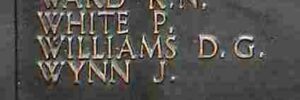The village of St. Dogmaels sits on the southern bank of the River Teifi, a mile South of Cardigan, on the Northern Border of Pembrokeshire. The village is famous for its Medieval Abbey, and for its Maritime heritage. The old War Memorial for the men of the village who lost their lives during both World Wars took the form of a wooden plaque, which is inside the Memorial Hall. This memorial was somewhat inaccurate, as it was hurriedly produced after the original memorial was destroyed and, as a result, the local heritage society based at St. Dogmaels Coach House carried out research, with the help of myself, in order to commission a new memorial in the village. This was unveiled on Armistice Day, 11 November 2014.
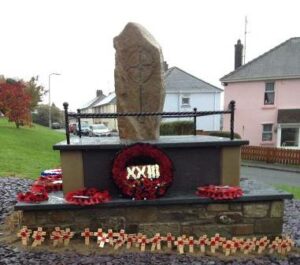
The Great War, 1914-1918
Francis John Barnard, Leading Seaman, 238015, Royal Navy. Francis was born on 31 August 1891, the son of Francis William and Elizabeth Emma Barnard, of Glanteifi, St. Dogmaels. By 1901 the family had moved to Stubbington, Hampshire. Francis enlisted into the Royal Navy on 31 August 1909, and by 15 December 1914 was serving aboard the armoured cruiser HMS Black Prince. She was stationed in the Mediterranean when the war began and participated in the pursuit of the German battlecruiser SMS Goeben and light cruiser SMS Breslau. Black Prince was sent to the Red Sea in August to protect troop convoys arriving from India and captured two German merchant ships. She was transferred to the Grand Fleet in December 1914. On 31 May 1916 the Grand Fleet engaged the German High Seas Fleet off the Jutland Peninsula. Towards the evening, Black Prince became separated from the fleet and later in the night began firing at the German battleship Rheinland. She then steamed directly into the line of German battleships and came under heavy fire, sinking in less than 15 minutes with the loss of all 857 of her crew. Francis was 25 years old when he was lost aboard Black Prince and is commemorated on the Portsmouth Naval Memorial, Hampshire. He is not commemorated locally.
David Craig, Leading Seaman, 161407, Royal Navy. David was born at Glasgow on 24 May 1875. He married prior to the war, and lived with his wife Eleanor at the Watch House, near the Ferry Inn at St. Dogmaels. David was a long serving Royal Naval rating, and at the outbreak of the Great War was serving aboard the Pembroke Dock built Scout Cruiser, HMS Amphion. On the morning of 6 August 1914, Amphion was returning from a search of the English Channel, when she struck a mine which had been laid the previous day. Amphion’s bridge and foredeck were destroyed in the blast, and the engines were shut off, leaving her to helplessly drift into more mines, which blew her up with the loss of 150 of her crew, including David Craig. David is commemorated alongside his shipmates on the Plymouth Naval Memorial, Devon.
Benjamin Davies, Apprentice, Mercantile Marine. Benjamin was the son of David and Catherine Davies (nee Edwards), of the Eagle, Castle Street, Cardigan. He served with the Mercantile Marine aboard the S.S. Treveal, a St. Ives registered cargo steamer. On 4 February 1918 Treveal was on route from Algiers for Barrow when she was torpedoed by the German submarine U-53 and sank off the Skerries, Anglesey with the loss of 33 lives. Benjamin was 19 years old when he died that day, and is commemorated on the Tower Hill Memorial, London. His brother David John Davies also fell.
David Davies, Private, 9363, King’s Own Yorkshire Light Infantry. David was born in St. Dogmaels in about 1885. He worked as a shoemaker before enlisting into the King’s Own Yorkshire Light Infantry at Pontefract on 21 September 1907. He served continuously with the regiment and was stationed in Cork when he married Mary Sullivan there on 30 August 1913. He embarked for France with the 1st Battalion, King’s Own Yorkshire Light Infantry on 10 August 1914 and took part in the retreat from Mons to the Marne, but within three weeks returned home after being wounded. By now his wife was living at 3, Ashbourne Terrace, West Parade, Hull and David joined her here to recover. Sadly, his health began to deteriorate and he was diagnosed as having contracted tuberculosis. David died at Hull on 23 March 1917, aged 32. He is buried in Hull Western Cemetery. David does not appear to be commemorated locally.
David Francis Davies, 200028, Company Quartermaster Sergeant, Welsh Regiment. David was born at St. Dogmaels, the son of John and Margaret Anne Davies, of James’s Terrace, St. Dogmaels. He worked at Haverfordwest prior to the outbreak of war, and was part of the Territorial Army. When War was declared in August, 1914, the Territorial’s were called up, and David joined up with his Battalion, the 4th Welsh, at Carmarthen, with the Battalion forming part of the South Wales Brigade. On 17 April 1915 the Battalion was attached to 159 Brigade, 53rd (Welsh) Division, and in July that year sailed with the Division to Alexandria, en route to Gallipoli. On 9 August 1915 the Division landed on Gallipoli, where they stayed until the middle of December, when after suffering severe losses, they were withdrawn to Egypt. In Egypt the Division guarded the Suez Canal, but were soon to move towards Palestine, successfully pushing back the armies of the Turkish Empire, who had defeated them at Gallipoli. In spring 1917 the Division attacked Gaza, and it was on the opening day of the Battle of Gaza that David was killed in Action aged 25, on 26 March, 1917. He has no known grave, and so is commemorated on Panel 30 of the Jerusalem Memorial. David is not listed on the War Memorial at St. Dogmaels.
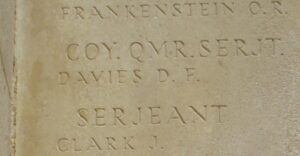
David John Davies, Gunner, Royal Garrison Artillery. David was the son of David Davies, of Llangunnor, and was the stepson of Catherine Davies (nee Edwards), of the Eagle, Castle Street, Cardigan. He served with the Royal Garrison Artillery. He was reported to have been killed in action on 6 May 1917. According to the census papers he would have been 32 years old, but his military service and death cannot presently be verified. His brother Benjamin Davies also fell.
Evan Owen Davies, 30370, Corporal, Machine Gun Corps. Evan was born in Eglwyswrw in 1888. He resided with his grandparents, William and Phoebe Evans for several years, prior to training as a Pharmacist in London. Evan enlisted at St. Dogmaels into the Middlesex Regiment, with the Army Number 156. He transferred into the 46th Company of the Machine Gun Corps, which was created by Royal Warrant, on 14 October, 1915. Evan’s Company, the 46th, was attached to the 15th (Scottish) Division from 11 February 1916 onwards. The Division fought in the latter stages of the Somme Battles of 1916, and were in the middle of the Battle of Le Transloy when Evan was killed in Action, on 13 October 1916. His body was lost on the Somme Battlefield, and so he is commemorated on the Thiepval Memorial, France.
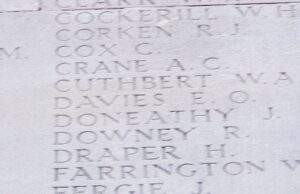
Herbert Thomas Davies, J/28606, Ordinary Seaman, Royal Navy. ‘Tom’ was born at Carew on 24 January 1898, the son of Benjamin and Ruth Davies. The family later moved to Glanteifon Cottage, St. Dogmaels. Herbert served aboard the mighty Battleship, HMS Queen Mary which was launched in 1912, joining the 1st Battlecruiser Squadron of the Grand Fleet. At the outbreak of the Great War, the Queen Mary was in the North Sea, and took part in the successful Battle of Heligoland Bight on 28 August 1914. During the first two months of 1915 the Queen Mary undertook a refit at Portsmouth, before again rejoining the Grand Fleet. During May, 1916 the Grand Fleet faced what was to become their sternest test of the war. Information had been received that the mighty German High Seas Fleet were assembling, and on 30 May the Grand Fleet put to sea. During the following afternoon of 31 May 1916, the great fleets sighted each other, and began what was to be the greatest Naval Battle in History, with the Queen Mary in the thick of the action. After exchanging heavy salvoes with their German opponents, the Queen Mary suffered direct hits from the Seydlitz and Derfflinger, and blew up with the loss of 1,266 crew. Herbert was one of these poor souls to lose his life in the tumultuous explosion caused by the direct hits, and so he is commemorated on the Plymouth Naval Memorial in Devon. He was just 18 years old.
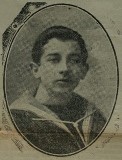
John Davies, 10936, Corporal, Worcestershire Regiment. John was born in St. Dogmaels, the son of William and Mary Davies. The family moved prior to the outbreak of War, to 26, Bank St., West Bromwich. John enlisted at Birmingham into the 14th Worcester’s, which were formed at Worcester on 10 September, 1915. The Battalion landed in France on 21 June 1916, where they joined the 63rd (Royal Naval) Division. The Division saw its first action on the Somme, during the Battle of the Ancre. After wintering on the Somme, the Division moved north to the Arras sector, taking part in the Battle of Arleux, alongside the Canadian Corps who took Vimy Ridge. Later that year they moved further north, to the Ypres sector, where they took part in the Second Battle of Passchendaele, before moving south, where they fought at the Battle of Welsh Ridge, which was a part of the larger Battle of Cambrai. After wintering in the Cambrai sector, on 21 March 1918, after a very heavy spell of gunfire on the British lines of the Fifth Army, the Germans attacked between Arras and St. Quentin. By noon that day, the situation was critical for the British. Their advance defensive positions had been captured and over-run, and the Fifth Army was in disarray. The 63rd Division at the time were stationed around Havrincourt Wood, and were caught up in the intense shelling of the area, and were forced to retreat, moving back to Ytres by 25 March. John was killed in Action on 25 March 1918 during this ferocious opening to the German Spring Offensive. His body was lost in the resulting mayhem, and so he is commemorated on Bay 6 of the Arras Memorial. He was 35 years old. John is not commemorated on the St. Dogmaels War Memorial.
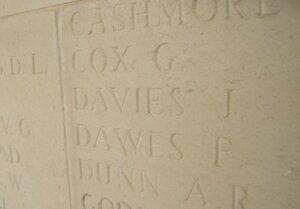
John Sidney Davies, 53333, Private, Royal Fusiliers. John was the son of Henry and Margaretta Davies, of Heathfield, St. Dogmaels. At the outbreak of war is recorded as living in London. He enlisted in London into the Royal Fusiliers, originally with the service number 656, which later changed to 53333 on his posting to their 9th Battalion, Royal Fusiliers. The battalion was attached to 36 Brigade, 12th (Eastern) Division. The Division had been in France since May 1915, and had fought in the Battle of Loos. In 1916 the division saw heavy fighting during the Somme offensive, and John probably joined the battalion during the summer of 1916. After suffering terrible casualties themselves, the Division were withdrawn, before being brought back into the line near Pozieres. They again fought at Le Transloy, before moving north to Arras in early 1917. The Battle of Arras opened on 9 April 1917, and the Division took the village of Roeux, before taking part in the Battle of Arleux on 3 May. John was killed in Action on 3 May 1917, aged 19. His body was lost on the Battlefield around Roeux, and so he is commemorated on Bay 3 of the Arras Memorial, France.
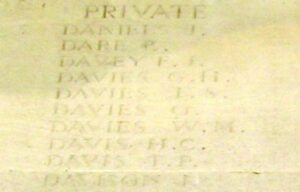
T. W. Davies, Mercantile Marine. This man cannot be identified.
Thomas Davies, 8839DA, Deck Hand, Royal Naval Reserve. Thomas was born on 30 September 1891, the son of Evan and Ann Davies, of St. Dogmaels. On the outbreak of War, the men of the Royal Naval Reserve were recalled to serve on re-commissioned ships. Thomas was posted aboard the transport ship HMS Sarnia, which was sent to the Mediterranean in early 1915 to act as a troopship for the Gallipoli landings. Disaster struck on 28 October 1915 at Mudros, when Sarnia was leaving Cape Helles, after landing troops on Gallipoli, when she struck the transport ship Hythe, creating a large gash inside the tightly crowded ship, which sank with 155 men aboard. The Sarnia survived with just the one casualty. The Sarnia served in the Mediterranean for the remainder of the war, but disaster struck again on 12 September 1918 when she was sunk by a torpedo from a German U-Boat. Thomas was drowned with the sinking of the ship, aged 28, and is commemorated on Panel 29 of the Plymouth Naval Memorial.
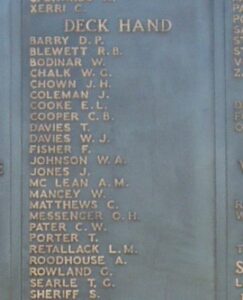
Thomas George Davies, Second Mate, Mercantile Marine. Thomas was born in St. Dogmaels, the son of Thomas and Jane Davies (nee Jones). The family later resided at 9, Great Western Crescent, Llanelly. Thomas served as Second Mate aboard the SS Dowlais, a 3,000 tonne defensively armed ship, based from Cardiff. On 3 December 1917 the Dowlais was off Cap de Fer when she was torpedoed without warning by a German Submarine, and sank with the loss of all hands. Thomas was 24 years old, and is commemorated alongside his crewmates on the Tower Hill Memorial in London.
Thomas Hector Davies, Third Engineer, Mercantile Marine. Thomas was the son of Thomas and Eleanor Davies, of River View, St. Dogmaels. He served as Third Engineer aboard the SS Marmion; a West Hartlepool registered Merchant Vessel. Marmion was sailing from Annaba, bound for Marseilles, with a cargo of emery iron on 26 August 1917 when she was torpedoed by the German submarine U38. Thomas went down with the ship that day. He was 23 years old, and is commemorated on the Tower Hill Memorial, London. His step-brother Thomas James Phillips also fell, but isn’t commemorated on the memorial.
William Dunstone, Gunner, 44120, Royal Garrison Artillery. William was born in St. Dogmaels in 1880, the son of Morgan and Margaret Dunstone, of St Dogmaels. He married Nellie Baker in 1916, whilst on leave after having enlisted at Tonypandy into the Royal Garrison Artillery. William was posted to their 18th Howitzer Battery, serving in Egypt and Palestine. Not much is known of William’s service in the Great War, but he Died of Sickness on 20 September 1918, aged 38, and is buried at St. Dogmaels (Blaenwaun) Chapelyard.
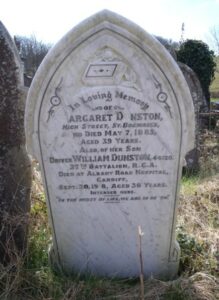
Thomas Evans, Seaman, 3646A, Royal Naval Reserve. Thomas was born on 22 May 1881, and was the Husband of Elizabeth Evans, of 7, David Street, St. Dogmaels. He served in the Royal Naval Reserve aboard HMS Majestic, a pre-dreadnought battleship. Thomas was called up from the Reserve to join the crew of the Majestic when she was re-commissioned for war in August 1914. After serving on the Dover Patrol, escorting troopships to France, Majestic was sent to the Mediterranean in February 1915, where she formed part of the Naval Task Force which had been sent there to attempt to force a passage through the Dardanelles. The attempt failed, and on 25 April 1915 British, French and Anzac troops landed on Gallipoli to attempt to capture the forts guarding the straits. On 27 May 1915, while stationed off W Beach at Cape Helles, Majestic became the third battleship to be torpedoed off the Gallipoli peninsula in two weeks, when at around 0645 hours, Commander Otto Hersing of the German submarine U-21 fired a single torpedo through the defensive screen of destroyers and anti-torpedo nets, striking Majestic and causing a huge explosion. The ship began to list to port and in nine minutes capsized, killing 49 men. Thomas was one of the dead. He was 34 years old, and is commemorated on the Plymouth Naval Memorial, England.
David Thomas Gibbons, Lance Corporal, 2132, Welsh Regiment. David was the son of Thomas and Mary Hannah Gibbons, of Castle Street, Cardigan. He enlisted at Cardigan into the 1/4th Battalion, Welsh Regiment, which was the local Territorial Battalion, attached to 159 Brigade, 53rd (Welsh) Division. The Division landed at Cape Helles, Gallipoli, on 9 August 1915, and was immediately thrown into action, spending the next few days in isolated pockets, fighting against a Turkish counter-attack during the Battle of Sari Bair, and then at the Attack on Scimitar Hill. David was killed in action during terrible fighting here on 11 August 1915. He was 23 years old, and is commemorated on the Helles Memorial, Gallipoli.
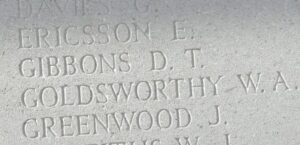
Samuel John Green, Captain, Mercantile Marine. Samuel was the son of Samuel and Jane Green, Billingham, Stockton-on-Tees. He married in 1898, and for several years prior to the war had resided with his wife Emma Green, at Norwood, St. Dogmael’s. Samuel served in the Merchant Navy aboard the SS Ashby. Samuel was 45 years old when he died after Ashby was wrecked near Ushant on 15 February 1916. His body was washed ashore in France, and buried at Lampaul Churchyard, Ile D’Ouessant, France. Samuel is not commemorated on the St. Dogmaels War Memorial.
Daniel James Griffiths, Private, 29032, Welsh Regiment. Daniel was the son of John and Ellen Griffiths, of 13, Castle Street, Cardigan. He married Mary Ellen Tierney in 1909, and the couple resided at Swansea, where they had raised their three children. Daniel enlisted at Swansea into the Welsh Regiment, and was posted to France where he joined the 2nd Battalion, Welsh Regiment, which was attached to 3 Brigade, 1st Division. He must have joined the battalion early in 1916, and joined the Battalion at Loos. The 2nd Welsh had reached Albert on 10 July 1916 after a six days march from the Loos area, and took up billets in Albert. Daniel was a member of 15 Platoon, who were billeted in a house in the town, when on 12 July a shell hit the building, killing 6 men and wounding 21 others. Daniel was amongst the dead, and is buried at Albert Communal Cemetery Extension, France. He was 29 years old. Sadly his widow, Mary had died in 1916, and their two children were orphaned.
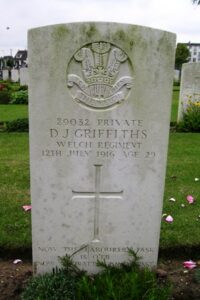
John Griffiths, Private, 302302, Manchester Regiment. John was the son of Jacob and Mary Griffiths, of Cwm, St. Dogmaels, and the husband of Margaret Ann Griffiths, of Fairfield, St. Dogmaels. He attested at Cardiff into the Army, and was posted to the 2/8th Battalion, Manchester Regiment, which formed part of 199 Brigade, 66th (2nd East Lancs.) Division. The Division concentrated on the Western Front by 16 March 1917 and moved to the Flanders Coast. At the end of September 1917 it moved to Ypres, and took part in the Battle of Poelcappelle. John was killed in action here on 9 October 1917. He was 39 years old, and is commemorated on the Tyne Cot Memorial, Belgium.
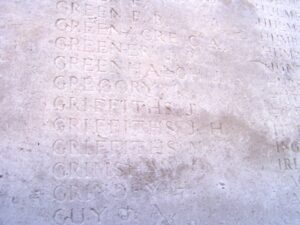
John Griffiths, Private, 5958, Royal Warwickshire Regiment. John was the son of Thomas and Mary Griffiths, of 27, Castle Street, Cardigan, and worked as a butcher in Cardigan prior to the war. He had enlisted at Cardigan into the 4th Battalion, Welsh Regiment, with the regimental number 2528, and was posted to the 2/7th Battalion, Royal Warwickshire Regiment. The battalion was attached to 182 Brigade, 61st Division, and on 21 May 1916 landed in France. The Division moved to the Fromelles area, taking over the line from the 38th (Welsh) Division, who were moving to the Somme. The Battle of the Somme had began on 1 July 1916, and the British had made no real inroads into the German defences there, so it was decided to make a feint attack at Fromelles, to attempt to keep the Germans from sending reinforcements to the Somme. On 19 July 1916 the 61st Division, and the 5th Australian Division made a suicidal assault against the strongly held German defences at Fromelles, and thousands of men were needlessly mown down. John was one of the dead that day, and was 32 years old. The regimental chaplain wrote a condolence letter to his sisters in Cardigan, stating that John had been buried and a cross erected on his grave. Sadly John is now another of the missing, and is commemorated on the Loos Memorial, France. He was thought to have possibly been one of the men buried at Fromelles in the mass grave, which was found several years ago, who had not so far been identified, but as the majority of the bodies recovered were of Australian soldiers, this is not likely.
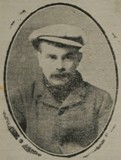
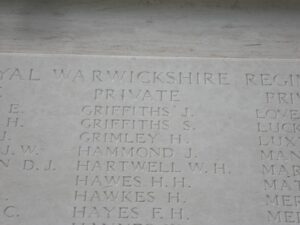
William David Harper, Second Engineer, Mercantile Marine. William was born at St. Dogmaels, the son of William Henry and Jane Harper, and the husband of Mary Anna Harper (nee Harries), of 3, Grange Town, Cardigan. William served during the Great War aboard the London based SS Cayo Bonito, a defensively armed merchant ship. On 11 October 1917, whilst four miles off Savona, she was torpedoed without warning and sunk by a German submarine. William was one of six men lost during the sinking. He is commemorated alongside his shipmates on the Tower Hill Memorial, London. William is not commemorated on the St. Dogmaels War Memorial.
David Emlyn Isaac, Cabin Boy, Mercantile Marine. Emlyn was born at St Dogmaels in 1902, the son of John and Susannah Isaac, of David Street, St. Dogmaels. He served with his friends Johnny Williams and Henry James Pope as a Cabin Boy aboard the S.S. Baykerran, a Glasgow built cargo steamer. On 19 January 1918 Baykerran sailed from New York for St Nazaire with a cargo of grain. She got into difficulties crossing the Atlantic and sent out a distress signal, but sank on 23 January 1918 with the loss of 41 lives. Edwin was just 16 years old when he died that day. As Baykerran was not a war casualty, none of the crew are commemorated by the CWGC, although three Royal Marine Gunners who died in her sinking are.
Benjamin James, Private, 33260, Welsh Regiment. Benjamin was born in St. Dogmaels, sometime moving to Caerau, Glamorgan, and enlisted at Maesteg into the 14th (Swansea City) Battalion of the Welsh Regiment, part of 114 Brigade, 38th (Welsh) Division. The Division moved to France during the end of 1915, wintering around Armentieres before moving south, where they took part in the Battle of Mametz Wood during July, 1916. They suffered terrible casualties at Mametz, and were taken out of the front line for almost a year, before being used in the Battle of Pilckem Ridge, where they regained some of the pride that the Division had unfairly lost at Mametz. The Division were in the Armentieres sector when the German Spring Offensive was launched in 1918, and it was here that Benjamin was killed in Action, during a German artillery bombardment on 2 April 1918. He is buried at Cite Bonjean Military Cemetery, Armentieres.
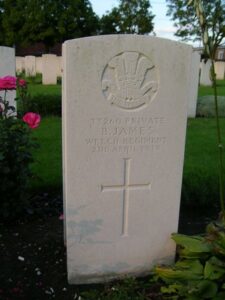
David James, Captain, Mercantile Marine. David was the husband of Annie James of Tyrhedyn, High Street, St. Dogmaels. He was a long serving mariner, and had retired prior to the war. He then volunteered to serve again in August 1914, and with his deep knowledge of the waters around Gibraltar, became a Pilot at Gibraltar. He suffered a heart attack and died in Gibraltar in June 1915, aged 60. Nothing more is known of him, as he is not commemorated by the CWGC. His son, David Thomas Emyr James was killed in 1917.
David Thomas Emyr James, Lieutenant, Mercantile Marine. David was born in 1885, the son of Captain David and Annie James of Tyrhedyn, High Street, St. Dogmaels. He was a long serving mariner, and prior to the war resided with his wife Annie James, at 12, Earlsfield Road, Sefton Park, London. David served aboard the White Star Liner, RMS Laurentic, which was requisitioned at the outbreak of war by the Admiralty, and converted to an Armed Merchant Cruiser. On 25 January 1917 the Laurentic was on a course to New York, carrying a cargo of 35 tonnes of Gold Bullion, when she struck a mine off Lough Swilly on the northern coast of County Donegal. She sank with the loss of 350 crew, among them was David. He was 31 years old, and is commemorated on Panel 23 of the Plymouth Naval Memorial. His father had died on active service in 1915.
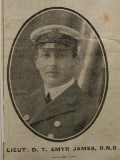
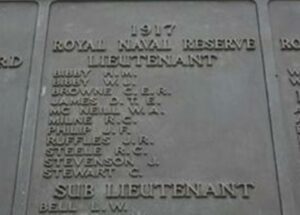
George James, Private, 27891, Kings Shropshire Light Infantry. George was born in 1899 at Salford, Manchester, the son of George James, of Moylgrove, and Mary Ann James, of Bala, Merioneth. His father had worked on the construction of the Manchester Ship Canal, before moving the family back to Pembrokeshire, where they took up residence at Union Terrace, St. Dogmaels. George enlisted at St. Dogmaels into the army, and was posted to the 4th Reserve Training Battalion, at Kinmel Park, before being posted to the 1/4th Battalion, King’s Shropshire Light Infantry. The battalion had spent two years in Singapore and Hong Kong at the outbreak of war, before being recalled to France, where it joined 190 Brigade, 63rd (Royal Naval) Division, and fought during the Battle of Passchendaele in 1917. After a winter in Flanders, the 1/4th KSLI moved to 56 Brigade, 19th Division. In 1918 they were caught up in the German Spring Offensive near St. Quentin, where they suffered terrible casualties, and fought at the Battle of Bapaume. They moved to Ypres, but were caught up in the German attack at Messines, and at Bailleul, and Kemmel. After suffering terribly again, they moved south to the quieter French sector to rebuild, but were caught up in the German offensive on the Aisne, and fought during the Battle of the Selle, where the KSLI earned themselves the award of the French Croix-de-Guerre for its part in the action of Bligny Hill, where the Germans were stopped. George was killed at Bligny on 7 June 1918, aged just 19. He has no known grave, and is commemorated on the Soissons Memorial, France.
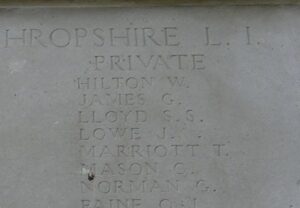
George Edward James, Private, 92110, Notts & Derby (Sherwood Foresters). George was the son of Joseph and Mary Jane James, of 6, Feidr Fair, Cardigan. He originally enlisted at Maesteg into the Army Service Corps, and had served with them in France from 15 November 1915, but in 1918, due to a shortage of front line troops, was posted to the 16th Battalion, Sherwood Foresters, which was attached to 117 Brigade, 39th Division. During the beginning of 1918 the battalion was stationed near St. Quentin, and was one of the Divisions to be hit hard here by the German Offensive which was launched on 21 March 1918. They fought here at the Battle of St Quentin, and falling back fought at the Actions at the Somme Crossings and the Battle of Rosieres. They were moved to Flanders to rest, but April was to see the Germans launch an attack here at the Lys, and the Division fought at the First Battle of Kemmel. George was killed in action here on 25 April 1918. He was 23 years old, and is incorrectly commemorated on the Pozières Memorial, France.
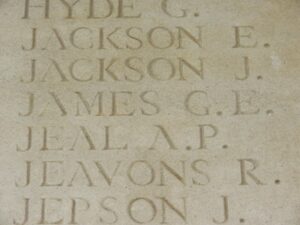
Benjamin David Jenkins, MM, Private, 31227, Royal Welsh Fusiliers. Benjamin was born at Boncath on 21 June 1894, the son of David and Sarah Jenkins. The family later moved to Jones Terrace, Pilot Street, St. Dogmaels. Benjamin enlisted at Carmarthen into the Royal Army Medical Corps in May 1915, with the service number 58253, but on 8 June was transferred to the 3rd Battalion, Royal Welsh Fusiliers. He was posted to France on 18 December 1915, and on 29 January 1916 was attached to the 1st Battalion, Royal Welsh Fusiliers, which was attached to 22 Brigade, 7th Division. The Division had been in France since the early days of the war, having returned back from Garrison duties around the Empire. Benjamin joined the battalion at Loos, before it marched southwards to take over positions on the Somme. The Division took part in one of the few successful attacks on the opening of the Battle on 1 July 1916, by taking the Village of Mametz, and fought on the Somme throughout the following months. It was whilst on the Somme, during the terrible winter holding the lines near the Ancre, when Benjamin was killed in Action, on 27 February 1917, aged 24. His body was lost in the muddy Ancre Valley, and so he is commemorated on the Thiepval Memorial, France. Benjamin was awarded the Military Medal for Bravery whilst in France, which was listed in the London Gazette of 10 October 1916, and was an award for the Somme.
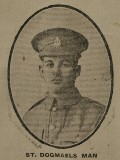
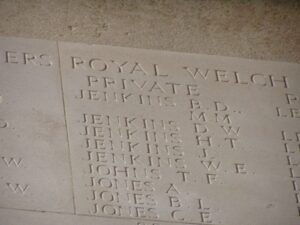
David Lawrence Jenkins, Seaman, 3312/C, Royal Naval Reserve. David was born in St. Dogmaels on 3 April 1883, the son of Evan and Elizabeth A. Jenkins, and was the the husband of Mrs. M. Evans Jenkins later of 99, Tanygroes Street, Port Talbot. David served aboard the Diadem Class Cruiser, HMS Europa. The Europa was stationed in the Mediterranean during 1915, being used as an escort for the many transport ships moving to and from Gallipoli, when David took ill. He died of sickness at Gibraltar on 21 November 1915 aged 28, and is buried at Gibraltar (North Front) Cemetery.
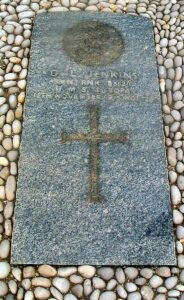
Dewi Peter John, Private, 49052, King’s Liverpool Regiment. Peter was born in 1892, the son of Daniel and Ann John, of Penrhiw, St. Dogmaels. He moved to Narberth prior to the outbreak of war, and enlisted at Preston into the Royal Field Artillery, with the service number 136559. Peter then transferred into the 17th Battalion (Liverpool Pals), Kings Liverpool Regiment, which formed part of 89 Brigade, 30th Division. The Battalion was the first ‘Pals’ Battalion to be formed, by Lord Derby, on 29 August 1914 at Prescot. They moved to France during November, 1915, and took part in the opening part of the Battle of the Somme, capturing Montauban. They stayed on the Somme for the duration of the battle, and followed up the retreating Germans during the early part of WW1, back toward the Hindenburg Line, before taking part in the opening of the Battle of Arras, fighting around the Scarpe. Peter was killed in Action during the Battle of the Scarpe on 28 April 1917. He was 24 years old, and is buried in a joint grave in Cherisy Road East Cemetery, Heninel.
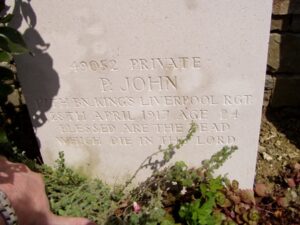
A. Jones, Private, South Wales Borderers. This man cannot presently be identified.
David Clifford Jones, Private, Royal Army Medical Corps. David was born in 1896, and was the son of Thomas Biddyr Jones, and of Anne Jones, of St. Dogmaels. He had trained in Cardigan as a chemist, and had served with the Royal Army Medical Corps in Salonika during the war. David moved to London to work as a chemist after being demobilised in 1919, and died at Lewisham, London, following a brief illness on 19 May 1920, aged 24. he was brought home for burial at St. Dogmaels on 31 May. He is not commemorated by the CWGC. His father Thomas was killed when his ship was lost on 12 December 1918.
David Owen Jones, Engineer, Mercantile Marine. David was born at Cardigan in 1875, the son of Mary Jones. By 1891 the family was residing at 1, Upper Spring Gardens, Cardigan. David became an engineer with the Mercantile Marine, and by the outbreak of war was serving aboard the oil tanker S.S. San Jeronimo, which was owned by the Eagle Oil Transport Company. He died on active service on 26 November 1916, aged 41. Nothing further can be traced of David, as he is not commemorated by the CWGC.
Griffith David Jones, Private, 53638, Royal Welsh Fusiliers. Griffith was the son of Evan and Mary Jones, of Trevigin Farm, Eglwyswrw. He enlisted at Carmarthen into the army, and was posted to France at some time late in 1916, joining the 1st Battalion, Royal Welsh Fusiliers, which was attached to 22 Brigade, 7th Division. Griffiths didn’t survive for long in France, as he was badly wounded when the 7th Division was following up the German retreat to the Hindenburg Line. He died on 30 March 1917, aged 30, and is commemorated on the Arras Memorial, France.
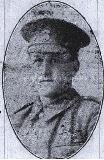
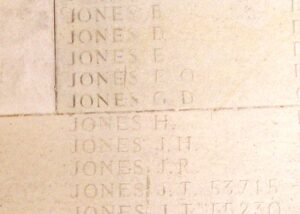
John Evan Jones, Private, 8760, Welsh Regiment. John was born in Pwllheli, but resided in St. Dogmaels immediately prior to the War. He enlisted at Maesteg into the 2nd Battalion, the Welsh Regiment, part of 3 Brigade, 1st Division. This was one of the first Divisions to land in France, fighting at the Battle of Mons, and taking part in the successful fighting retreat through the Marne and the Aisne. John was wounded at this early stage in the war, and brought back to the Base Hospital at Boulogne. Sadly he Died of Wounds, aged 28, on 6 November 1914 and is buried at Boulogne Eastern Cemetery.
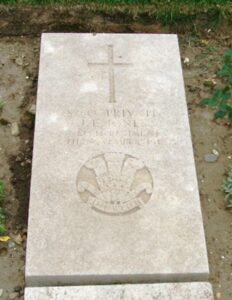
Thomas Biddyr Jones, Master, Mercantile Marine. Thomas was born at St. Dogmaels in 1871, and was the husband of Anne Jones, of Glantivy, St Dogmaels. He served in the Mercantile Marine. Thomas had an interesting career, he was Master of the Penzance when it was involved in a collision in 1894, which resulted in his Certificate being suspended for 18 months. He was then aboard another vessel which was wrecked, and another which was stranded on Goodwins. Another vessel was stranded in the Black Sea, after she struck a rock and foundered. The loss was judged as not caused by wrongful act or default of the Master but grave error of judgement was committed in not attempting to beach vessel. Thomas was then aboard the SS Geraldine, which foundered on 5 February 1916. Nothing more is known of him, except that he died at sea on 12 December 1918.
John Ladd, Private, 203599, Yorkshire Regiment. John was born at St. Dogmaels in 1878, the son of William and Phoebe Ladd. Prior to the war his family had moved to The Mount, Eglwyswrw, while John resided at 194, Ystrad Road, Pentre with his wife Edith Ann Ladd, and their three children. He enlisted at Pentre, Glamorgan, into the 2/4th Battalion, the Yorkshire Regiment, which had been formed on 4 September 1914 for Home Service. On 1 March 1916 they were attached to 189 Brigade, 63rd (Royal Naval) Division, and were transferred on 9 November 1916 to 220 Brigade, 73rd Division. The Division remained on Home Service, and John Died of Sickness at home on 16 April 1917, aged 39, without having seen active service. He is buried at Rhondda (Treorchy) Cemetery. His brother Owen was drowned on the RMS Lusitania.
John Emrys Ladd, Private, 235040, Royal Welsh Fusiliers. John was born at Moylegrove, the son of Charles and Hannah Ladd, of Trefaes, Moylegrove. The family had emigrated to Patagonia, where they resided for several years prior to returning home prior to John’s birth. John married Martha Rees in 1913, and the couple resided at Danybryn, St. Dogmaels. John enlisted at Brecon into the South Wales Borderers, with the service number 3847, but later transferred into the 10th Battalion, Royal Welsh Fusiliers, which was attached to 76 Brigade, 25th Division. On 15 October 1915 they transferred with the Brigade into the 3rd Division, seeing action at Hooge and Bellewaarde, before moving south to take part in the Battle of the Somme, in July 1916. The Division fought through the Battle of the Somme, and captured Longueval, before moving north to Arras, where they played a big part in the Battle of Arras, capturing Roeux. John was wounded after the Battles of Arras, and sadly died of wounds on 15 June 1917, aged 23. He is buried in Duisans British Cemetery, Etrun.
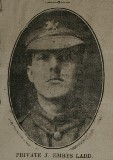
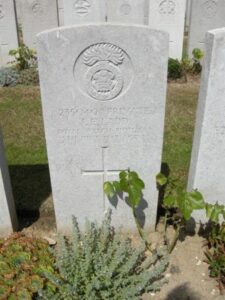
Owen Ladd, Civilian. Owen was born at St. Dogmaels in 1882, the son of William and Phoebe Ladd. His parents later moved to The Mount, Eglwyswrw, while Owen had moved to Pentre, Rhondda, where his brother John resided. Owen had gone to Canada prior to the war and lived at 218, Carlton Street, Winnipeg, Manitoba, Canada, where he worked as a jeweller and had acted as secretary for a touring Welsh choir. His elder brother David James Ladd was already living in Winnipeg with his wife Allie Dee Ladd. Owen only lived in Manitoba for a couple of years. By 1915 he had decided to go home to live with his parents at Eglwyswrw, and sailed from New York aboard the White Star Liner R.M.S. Lusitania on 1 May 1915. Despite warnings of submarine activity, Lusitania rounded Ireland on 7 May without an escort and was torpedoed by the German submarine U-20. Owen was among 1,195 people aboard Lusitania who drowned in her subsequent sinking. His body was never recovered, so Owen does not have the luxury of a grave, nor a place on a memorial, and is not commemorated anywhere locally (for now). He was 33 years old. His brother John died on 16 April 1917. A third brother, William Arthur Ladd, was awarded the Meritorious Service Medal for devotion to duty during the war, and died at Haverfordwest.
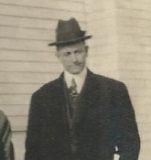
David Lloyd, Sapper, 3082428, Canadian Engineers. David was born on 5 August 1883, the son of Evan and Elizabeth Lloyd, of The Orchard, St. Dogmaels. He had emigrated to America, living at 55, Whitney Street, Roxbury, Massachusetts, when he enlisted into the Canadian Expeditionary Force at Montreal on 4 March 1918. The Battalion were attached to the 3rd Canadian Division, and upon David’s arrival in France in mid 1918, the Canadians were pushing the Germans back to the Hindenburg Line. David was attached to ‘D’ Company of 7th Battalion, and on 31 October 1918 they were hard at work widening roads leading to the front near Bruay, when a German shell landed among the working party. David was killed along with an Officer of his Battalion in the explosion. He was 34 years old, and is buried in Auberchicourt British Cemetery, France.
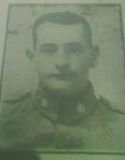
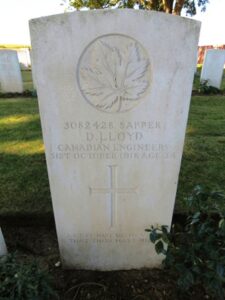
Thomas Llewellyn McFadden, Second Mate, Mercantile Marine. Thomas was born at Mostyn, North Wales, the son of James and Mary Ann McFadden. The family then moved to St. Dogmaels, where Thomas was raised, before moving again to 40, Sandfield Row, Burry Port, after the death of Thomas’ father. Thomas served as Second Mate aboard the SS Framfield, a London registered Merchant Vessel. Little is known about the ship, except that it struck a German mine and sank on 24 October 1916. Thomas went down with the ship. He was 23 years old, and is commemorated on the Tower Hill Memorial, London.
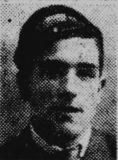
John Morgan Morris, Private, 2193, Australian Imperial Force. John was the son of John and Ann Morris, of Forest House, St. Dogmaels. He had emigrated to Australia, and enlisted at Newcastle, N.S.W. on 9 May 1916 into the 36th Battalion, Australian Imperial Force. John embarked at Sydney aboard the HMAT Anchises, and disembarked at Devonport on 11 October that year. On 11 November 1916 his papers show that he marched to join the 3rd Australian Division, proceeding to France on 22 November. John was wounded at Ypres on 11 July 1917, and was brought to the 10th Australian Field Ambulance, where he died of Wounds that same day. He was 45 years old, and is buried in Kandahar Farm Cemetery near Ypres.
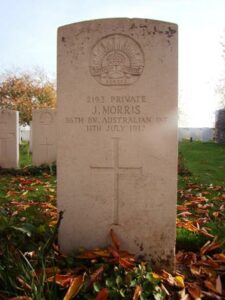
William Henry Every Niles, Commander, Royal Naval Reserve. William was born in 1859, the son of William Henry Niles and Jane Niles (nee Blight), of Marine Villa, St. Dogmaels. He had served at sea, as did his father, for many years, as Captain of a merchant ship exporting copper from Swansea, and later became the Dockmaster at Swansea, remaining in the Royal Naval Reserve. He had married Elizabeth Rees at Swansea in 1884, and the couple had two children, Elizabeth and William. During 1903 William became Commander of the Port of Gibraltar. The strains of his command took a heavy toll on his health, and William died at home in 16, Woodlands Terrace, Swansea on 7 November 1917, aged 58. He was buried with full military honours at Sketty Chapelyard.
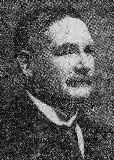
Thomas Owen, Private, 201699, Welsh Regiment. Thomas was born in St. Dogmaels. He enlisted at Carmarthen into the 4th Battalion of the Welsh Regiment, which was a Territorial Battalion, forming part of the South Wales Brigade. On 17 April 1915 the Battalion was attached to 159 Brigade, 53rd (Welsh) Division, and was sent to Gallipoli, arriving there on 9 August 1915. They gave a good account of themselves on Gallipoli, but when the blizzard of November 1915 hit the Peninsula, the Battalion suffered terrible casualties, necessitating their having to merge temporarily with the 1/5th Welsh, forming the 4/5th Composite Battalion. The Division were evacuated soon after, arriving in Egypt on 23 December that year. For the next eight months the Division guarded the Suez Canal, before moving to Palestine, fighting in the Sinai Desert, and taking part in the First Battle of Gaza in 1917. Thomas was killed in Action during the First Battle of Gaza, on 26 March 1917, and is commemorated on the Jerusalem Memorial, Israel.
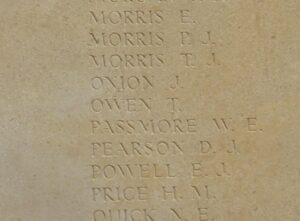
Thomas James Phillips, Engine Room Artificer, M/132, Royal Navy. Thomas was born at St. Dogmaels on 14 May 1892, the son of John and Margretta Phillips. After his mothers death in 1898, Thomas remarried, and moved the family to 54, Court Road, Barry Dock, Glamorgan, where he was the Pier Master. Thomas served aboard the Battle Cruiser HMS Invincible, who was attached to the 1st Battle Squadron of the Home Fleet. The Invincible saw action at the Battle of Heligoland Bight, and at the Battle of the Falkland Islands, before taking part in the famous Battle of Jutland on 31 May 1916. She took a direct hit from a salvo from the SMS Lutzow, blowing up with the loss of over 1,000 of her crew, including 24 year old Thomas. He is commemorated alongside his crewmates on the Portsmouth Naval Memorial. His step-brother, Thomas Hector Davies, also fell. Thomas is not commemorated on the St. Dogmaels War Memorial.
Henry James Pope, Mercantile Marine. Henry was the son of Arthur James Pope and May Pope, of Church Cottage, St. Dogmaels. He served with Emlyn Isaac and Johnny Williams in the Mercantile Marine aboard the cargo steamer, S.S. Baykerran. On 19 January 1918 Baykerran sailed from New York for St Nazaire with a cargo of grain. She got into difficulties crossing the Atlantic and sent out a distress signal, but sank on 23 January 1918 with the loss of 41 lives. Henry was 18 years old when he died that day. As Baykerran was not a war casualty, none of the crew are commemorated by the CWGC, although three Royal Marine Gunners who died in her sinking are.
Joseph Jenkins Protheroe, MM, Private, 12539, Somerset Light Infantry. Joseph was born at Cardigan in 1881, the son of Esther Protheroe, a sailors wife. He worked as a miner at Ystradfodwg prior to the war, and enlisted at Ferndale into the 7th Battalion, Somerset Light Infantry. The battalion was attached to 61 Brigade, 20th (Light) Division, which landed in France on 26 July 1915, moving to the Fleurbaix Sector for trench familiarisation and training. When the Battle of Loos was launched on 25 September 1915 the Division fought a diversionary attack towards Fromelles. Later that year they moved north, and fought at the Battle of Mount Sorrel alongside the Canadian Corps. They then fought through the Somme Offensive. Joseph was killed at the Battle of Delville Wood on 1 September 1916. He was 35 years old, and is buried at Dantzig Alley British Cemetery, Mametz, France. He had been awarded the Military Medal just previous to his death.
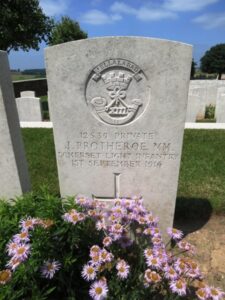
George Gordon Rees, Private, 2720, Welsh Guards. George was the son of Thomas and Elizabeth Rees, of Cippin, St. Dogmaels. He enlisted at Carmarthen into the 1st Battalion, Welsh Guards, part of 3 Guards Brigade, Guards Division. The Welsh Guards had been formed by Royal Warrant on 26 February 1915, and on 18 August 1915 moved to France. They were blooded at the Battle of Loos, and then fought on the Somme, during the Battles of Flers and of Morval. They wintered on the Somme, and it was here that George took ill. He was transferred to 32 Stationary Hospital at Wimereux, where he died of tuberculosis on 23 February 1917, aged 29. George is buried in Wimereux Communal Cemetery, France.
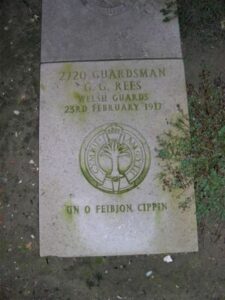
Thomas John Rees, Private, 332385, King’s Liverpool Regiment. Thomas was born in Troedyrhiw, St Dogmaels in 1892, the son of Hannah Rees. His mother later married George Davies and the family moved to 27, Moscow Drive, Stonycroft, Liverpool. Thomas enlisted there into the King’s (Liverpool) Regiment and was posted to France with the 9th Battalion, King’s (Liverpool) Regiment, which was attached to 172 Brigade, 57th (2nd West Lancs) Division. The Division moved to France during February 1917, and moved to positions near Ypres, where it took part in the Second Battle of Passchendaele. In 1918 it took part in the great 100 days offensive and it was during this push towards the Hindenburg Line that Thomas was killed in action on 2 September 1918, aged 26. He is buried in Quéant Road Cemetery, Buissy, France. Thomas is not commemorated locally.
Benjamin Richards, Private, 128854, Machine Gun Corps. Benjamin was the son of Joshua and Patsy Richards, of Union Terrace, St. Dogmaels. He enlisted at Treorchy into the Monmouth Regiment, with the service number 47085. In early 1916, Battalion Machine Gunners were transferred into newly formed Machine Gun Companies, and Benjamin joined the 59th Battalion, M.G.C., joining the 20th (Light) Division on 3 March 1916. The Division fought at the Battle of Mount Sorrel during June, 1916 alongside the Canadians, then were moved south to the Somme, fighting at Delville Wood, Guillemont, Flers, Morval and Le Transloy. They moved north to Ypres, taking part in several stages of the Battle of Passchendaele, and also fought at the Battle of Cambrai, and the 1918 Battles of St. Quentin, the Somme Crossings and Rosieres. Benjamin was taken Prisoner by the Germans at some stage in 1918, and Died in captivity on 3 July 1918, aged 25. He is buried in Niederzwehren Cemetery, Germany.
William Lloyd Richards, Pioneer, 195930, Royal Engineers. William was the son of the Reverend David and Evangeline Richard, of The Manse, St Dogmaels. He enlisted in Cardigan into the Royal Engineers. William was posted to No. 3 Special Company, which was a Gas Company, the Chemical Warfare experts of the day. The Great War was the first in which chemical weapons were deployed. There was great moral shock and outrage at the first use of Chlorine, released by the Germans against defenceless French troops in the Ypres Salient in April 1915, however its use soon became widespread, so Special Companies of the Royal Engineers were formed to develop the British response. By 1918, gas was used both offensively and defensively, delivered by a range of sophisticated techniques, including the release from bottles and from specially designed gas shells. William was wounded before the end of the War, suffering gassing himself. He returned home for treatment, but died as a result of his gas wounds on 6 October 1919, aged 22. He is buried in Glanrhyd Calvinistic Methodist Chapelyard. His youngest brother, George Iorwerth Richards, died at sea in 1922.
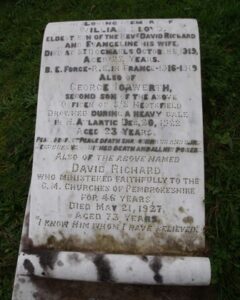
William Baxter Roberts, Driver, 701699, Royal Field Artillery. William was born at Machynlleth in 1884, and was a boot and shoe salesman at Oakford, North Road, Cardigan prior to the war. He married Mary Lavinia Sharpe, a domestic servant, of Green Meadow, St. Dogmaels prior to enlisting at Cardigan into the Army. William was posted to the Royal Field Artillery, joining their B Battery, 330th Brigade. The Battery was attached to the 66th Division from March 1917 to March 1918, and fought through the Battle of Poelcappelle. William was killed in action here on 31 July 1917. He was 33 years old, and is buried at Coxyde Military Cemetery, Belgium. William is not commemorated on the St. Dogmaels War Memorial, but at nearby Cardigan.
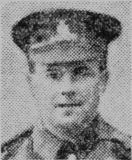
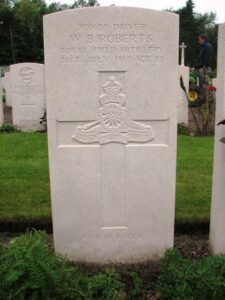
Alfred William Thomas, Second Engineer, Mercantile Marine. Alfred was born at St. Davids, and was the Husband of Hetty Isabella Thomas, of 2, Lloyd’s Terrace, St. Dogmaels. He had been secretary at St. Mary’s Church, Cardigan prior to the war, and joined the Mercantile Marine as an Engineer, serving aboard the SS Memnon, a Liverpool registered ship. The Memnon was a 3,203grt British Merchant steamer. On 12 March 1917 when twenty miles South-West from Portland Bill in the English Channel she was torpedoed without warning and sunk by German submarine UC-66. Six lives were lost, Alfred being one of them, after he had just gone below to the engine room to carry out some work, just before the torpedo struck. He was 29 years old, and is commemorated on the Tower Hill Memorial, London. Alfred was awarded a medal for gallantry at sea, for saving the life of a fellow crewman who fell overboard in shark infested waters while at sea in 1912.
David John Thomas, Private, 561, Australian Infantry. David was born in 1883, the son of Lewis and Elizabeth Thomas. The family later resided at 2, Bryntivy, St. Dogmaels, and then at Brynteg, Henllan. David had emigrated to Australia prior to the war along with his brother James Louis Thomas, and after the declaration of war, both brothers enlisted into the Australian Imperial Force. David attested at Perth into the 44th Battalion, AIF, and embarked at Fremantle on 6 June 1916 aboard the HMAT Suevic, bound for England. David was then posted to his Battalion in France on 16 March 1917, after spending two months in hospital in England. The Battalion spent most of May 1917 training near Armentieres, and at the end of the month moved to Ploegsteert, where they took up billets in the catacombs, providing working parties within the wood. David was killed during his first day at Ploegsteert on 1 June 1917. He was 34 years old, and is buried at Strand Military Cemetery, Belgium. His Brother, James Louis Thomas, died the previous year, and another brother, Lewis Robson Thomas, was killed in World War Two. David is commemorated at Sarnau, and not on the St. Dogmaels War Memorial.
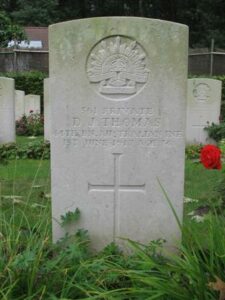
David Rees Thomas, Captain, Mercantile Marine. David was born in 1877, the son of Elizabeth Thomas, of Dychfelva, St. Dogmaels. David was a long serving Mariner, and resided with his wife Lizzie Hannah Thomas, at 2, Pembroke Terrace, St. Dogmaels. David worked for the Reardon Smith line, and was Captain of the SS Eastern City early in the war. On 9 April 1916, Eastern City was on route from St. Nazaire from Barry Roads when she was captured by the German submarine U-66 and was sunk by gunfire. David survived the sinking of his ship, and after recovering from his ordeal was appointed Captain of the SS Great City. During 1917 Great City was torpedoed, and initially abandoned by her crew, but they re-boarded her after realising that she would remain safely afloat, and sailed her back to port. David’s health must have suffered from his ordeals, and he died on 2 December 1917, aged 40. David is buried at Blaunwaen Baptist Chapelyard, St. Dogmaels, but is not commemorated by the CWGC.
James Louis Thomas, Private, 2936, Australian Infantry. James was born in 1888, the son of Lewis and Elizabeth Thomas, later of Brynteg, Henllan. He had emigrated to Australia along with his brother David prior to the war, and enlisted there at Blackboy Hill into the Australian Imperial Force. James was posted to the 48th Battalion, AIF, which was in France attached to the 12th Australian Brigade, 4th Australian Division. On 5 October 1915 James embarked at Fremantle aboard the HMAT Hororata, and arrived at Ismailia on 8 January 1916. On 9 June 1916 the 48th Battalion landed at Marseilles, and moved to Bailleul. The Division moved to the Somme at the end of July 1916, and took up positions in Sausage Valley, while the 2nd Australian Division was fighting at Pozieres, and got ready to move into the line to replace them. James was killed just days after, when his battalion moved through the battered ruins of Pozieres, to attack the German positions near the Windmill on 6 August 1916. He was 33 years old, and is commemorated on the Villers-Bretonneaux Memorial, France. His brother David was killed at Ypres the following year and another brother, Lewis Robson Thomas, was killed in World War Two. James is commemorated at Sarnau, and not on the St. Dogmaels War Memorial.
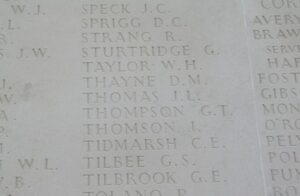
Benjamin Williams, Private, 200492, Welsh Regiment. Benjamin was the son of Benjamin and Margaret Williams, of Rose Lynn, St. Dogmaels. He enlisted at Cardigan into the 15th (Carmarthenshire) Battalion, the Welsh Regiment, part of 114 Brigade, 38th (Welsh) Division. The Division arrived in France at the end of 1915, moving to positions around Armentieres, and saw their first major engagement during the Battle of Mametz Wood, where the terrible casualties incurred by the Division during the Successful capture of the wood saw them moved out of action for almost twelve months. They next saw action at Ypres, and it was here, during the Battle of Pilckem, that Benjamin was Killed in Action on 26 July 1917 aged just 20. He is buried at Bard Cottage Cemetery. His brother David (see next entry below) had been Killed in Mesopotamia just six months previously, and another brother Johnny was posted as missing when his ship sank on 23 January 1918.
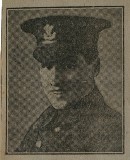
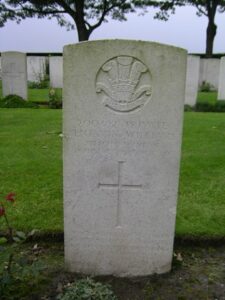
David Williams, Private, 17277, Royal Welsh Fusiliers. David was the son of Benjamin and Margaret Williams, of Rose Lynn, St. Dogmaels. He enlisted at Aberdare, into the 8th Battalion, Royal Welsh Fusiliers, which was attached to 40 Brigade, 13th (Western) Division. The Division concentrated at Blackdown, Hampshire during February, 1915, where they received orders to embark for the Mediterranean. During July 1915 the Division landed on Cape Helles, taking part in the Battles of Sari Bair, Russell’s Top, Hill 60, and operations at Suvla Bay. They were evacuated from Helles between 8 and 9 January 1916, and by the end of January were positioned along the Suez Canal defences. During February, the Division moved to Mesopotamia, where they unsuccessfully attempted to relieve the besieged town of Kut. After the attempt failed, Kut fell to the Turks, and the Division then reorganised, taking part in the later, more successful Second Battle of Kut al Amara, the Advance on Baghdad, where David was killed in Action on 25 January 1917, aged 24. He is commemorated on the Basra Memorial, Iraq. His brother Benjamin (see entry above) was Killed in France just six months later, and another brother Johnny was lost when his ship was posted missing in 1918.
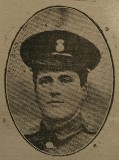
Herbert John Picton Williams, Sergeant, 13570, Royal Welsh Fusiliers. Herbert was born at St. Dogmaels, the son of Monat Thomas Williams and Emily Williams. The family resided at Llanelli for several years prior to moving to 104, College Street, Ammanford. Herbert enlisted at Llanelli into the 9th Battalion, Royal Welsh Fusiliers, which was attached to 58 Brigade, 19th (Western) Division. The units of the Division assembled around Bulford during September, 1914, and crossed to France throughout July 1915. They saw action at the Battle of Loos, then moved to the Somme, where they took part in one of the few successes of the opening few days of the Battle, capturing La Boisselle. Herbert was Killed in Action at La Boisselle, on 3 July 1916, aged 30. His body was lost on the battlefield, and so he is commemorated on the Thiepval Memorial, France.
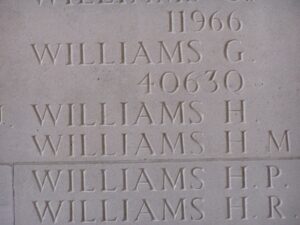
Johnny Williams, Sailor, Mercantile Marine. Johnny was the son of Benjamin and Margaret Williams, of Rose Lynn, St. Dogmaels. He served with Emlyn Isaac and Henry James Pope in the Mercantile Marine aboard the cargo steamer, S.S. Baykerran. On 19 January 1918 Baykerran sailed from New York for St Nazaire with a cargo of grain. She got into difficulties crossing the Atlantic and sent out a distress signal, but sank on 23 January 1918 with the loss of 41 lives. Johnny was 23 years old when he died that day. As Baykerran was not a war casualty, none of the crew are commemorated by the CWGC, although three Royal Marine Gunners who died in her sinking are.
John Ernest Williams, Second Officer, Mercantile Marine. John was born in 1894, the son of Louisa Williams, of Green Meadow, St. Dogmaels. He followed his father into the Mercantile Marine, and served aboard the steamship S.S. Denby Grange. On 24 October 1918 Denby Grange was en route from Newport to Spezia with a cargo of coal, when she collided with the SS War Island, and sank. John was 23 years old when he died that day, but because he was not a casualty of war, is not commemorated by the CWGC.
World War Two, 1939-1945
David Baum, Second Officer, Merchant Navy. David was the son of Henry and Ellen Baum of Nevin, Carnarvonshire. He was a Merchant Mariner, and was based at Cardiff when he married Louisa Jane Hurrill, the daughter of Sergeant Hurrill, of the Cardigan Volunteers in 1904. The family then moved to St. Dogmaels by 1911. David served throughout the Great War, and in 1937 retired from the Merchant Navy. He volunteered to serve again at the outbreak of war, and was posted aboard the S.S. Stanholme, a London registered cargo steamer. On 25 December 1939, she was en route from Cardiff to London with a cargo of coal, when she struck a mine, which had been laid by the German submarine U-33, and sank with the loss of 13 of her crew. David was 68 years old when he died that day, and is commemorated on the Tower Hill Memorial, London. His widow, Louisa, never remarried, moved back to Cardiff after the war, and died in 1948, aged 76. David is not named on the St. Dogmaels Memorial.
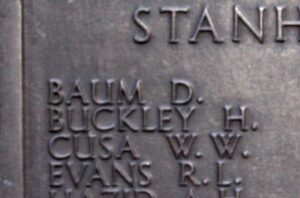
Idris Burrows, Sapper, 2152724, Royal Engineers. Idris was the son of Thomas and Sarah Jane Burrows, of Tonypandy. His wife, Eluned May Burrows (nee Davies) resided at Brynderi, St. Dogmaels, the daughter of John and Martha Davies. Idris served with the 864 Mechanical Equipment Company, Royal Engineers in the Far East. He died on active service on 29 July 1944, aged 40, and is buried at Delhi War Cemetery, India. His widow, Eluned, never remarried, and died in 1996. Idris is not named on the St. Dogmaels Memorial.
Ivor Gordon Davies, Third Radio Officer, Merchant Navy. Ivor was the son of Morgan and Elizabeth Davies, of St. Dogmaels. He served with the Merchant Navy aboard the S.S. Montreal City, a Bristol registered cargo steamer. On 21 December 1942 Montreal City was on route from Bristol to New York, but was struggling to keep up with her convoy, when she was torpedoed by the German submarine U-591, and sank with all hands. Ivor was 17 years old when he died that day, and is commemorated on the Tower Hill Memorial, London.
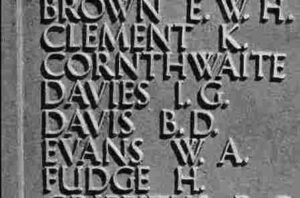
George Rhys Evans, Flight Sergeant, 656618, Royal Air Force Volunteer Reserve. George resided at Mount Pleasant, High Street, St. Dogmaels. He served with the Royal Air Force as an Air Bomber with 405 (R.C.A.F.) Squadron, Royal Air Force. On the night of 2 January 1944 George took off as a crewman in Lancaster MkIII, Serial ND330 for a raid on Berlin. The Lancaster was brought down by enemy fire at Wahrenholz in the early hours of 3 January 1944, killing all her crew of eight men, including George. All of the men are buried at Hanover War Cemetery, Germany.
Lynn Griffiths, Able Seaman, Merchant Navy. Lynn was the Husband of D. M. Griffiths, of St. Dogmaels. He served with the Merchant Navy aboard the S.S. Albionic, a Hull registered steamship. On 31 August 1940, Albionic left Wabana, Newfoundland for Liverpool with a cargo of iron ore. Nothing more was heard of the ship or of any of her crew, and she was presumed lost on 11 September 1940, possibly torpedoed by the German submarine U-99. Lynn was 33 years old when he died, and is commemorated on the Tower Hill Memorial, London.
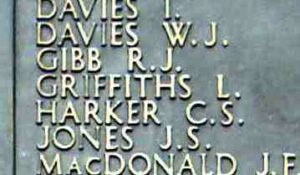
Edward Gwynfryn Isaac, Lance Serjeant, 807789, Royal Artillery. Edward was the son of John and Susannah Isaac, of Groesyllan, St. Dogmaels. He served with 146 Field Regiment, Royal Artillery, which was the Pembrokeshire and Cardiganshire Yeomanry unit. The unit was training in North Wales prior to a move to the south of England, where it assembled before embarking to join the 8th Army (Desert Rats) in North Africa when Edward died on 30 January 1940, aged 30. He is buried in Blaen-Y-Ffos Baptist Chapelyard.
George Iorwerth James, Leading Aircraftman, 1497286, Royal Air Force Volunteer Reserve. George was the son of John and Annie James, of Prospect House, St. Dogmaels. On 3 February 1943 George was part of a crew taking part in a night flying bombing exercise aboard an Avro Anson aircraft, Serial N4995, when it was reported as missing. The aircraft was found on Cairn Hill, near Barr, Ayrshire. All of the crew were safe, but George had been seriously injured, and died on 4 February 1943, aged 22. George was brought home for burial at St. Dogmells (Blaenwaun) Chapelyard.
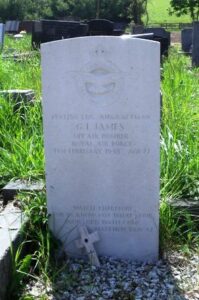
John Richard Idris James, Apprentice, Merchant Navy. Idris was the son of David John James and Margaret M James (nee Owen), of Degwel Cottage, St. Dogmaels. He served with the Merchant Navy, and was an Apprentice aboard the S.S. Treworlas, a St. Ives registered Cargo Steamer. On 28 December 1942 she was on route from Massowah for Baltimore carrying a cargo of manganese ore when she was torpedoed by the German submarine U-124 and sunk with the loss of 38 lives. Idris was just 19 years old when he died that day, and is commemorated on the Tower Hill Memorial, London.
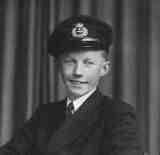
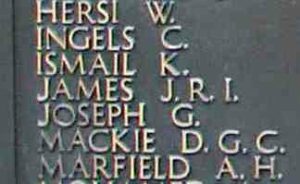
John Evan Eric Jenkins, Sailor, Merchant Navy. John was born on 27 July 1919, the son of Evan Thomas Jenkins and Mary Ann Jenkins of 3, Church Lane, St. Dogmaels. He served with the Merchant Navy aboard the S.S. Caledonian Monarch, a Glasgow registered merchant steamer. On 7 January 1942 the Caledonian Monarch was straggling from Convoy SC-63, which was en-route from Rosario via Halifax and Loch Ewe for London, and was reported as having been lost on 14 January 1942, presumably due to enemy action. John was 22 years old when he was lost aboard Caledonian Monarch, and is commemorated on the Tower Hill Memorial, London. His parents later lived at Cwm, Montgomeryshire.
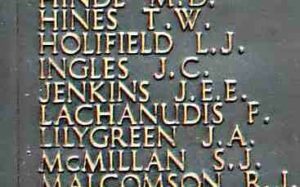
David Hedley Jones, Flight Sergeant, 625737, Royal Air Force. David served as a Wireless Operator/ Air Gunner with 502 Squadron, Royal Air Force. The squadron was a Coastal Command Squadron, and on the outbreak of war began patrols off the Irish coast, first with Avro Ansons and then, from October 1940, with Armstrong Whitworth Whitleys. Little else is known of David, but he died on 23 August 1941, and is buried at St. Dogmells (Blaenwaun) Chapelyard.
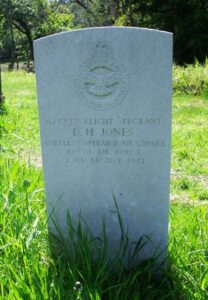
David Owen Jones, Second Engineer Officer, Merchant Navy. David was born in Cardigan on 1 December 1896, and was raised by his grandmother Susan Jones at 3, Tivy Terrace, St. Dogmaels. He lived with his wife, Mrs M. A. Jones at 63, Pomery Street, Docks, Cardiff prior to the war and served aboard the London registered merchant steamer S.S. Llanashe. On 17 February 1943 Llanashe was torpedoed and sunk by the German submarine U-182 south of Cape Saint Francis, Cape Colony, with the loss of 32 lives. David was 46 years old when he died that day and is commemorated on the Tower Hill Memorial, London.
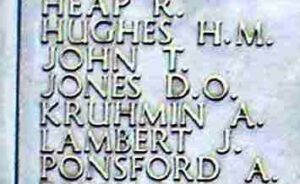
Philip John Gwyn Jones, Third Engineer Officer, Merchant Navy. Philip was born on 11 June 1916, the son of Thomas Jones and Sarah Jones (nee Richards), of Cross House, St. Dogmaels. He had married Esther A. Jones in 1940 and the couple had briefly lived at Camden Town, London. Philip served aboard the merchant steamer S.S. Thornliebank. On 29 November 1941 Thornliebank was en-route from Barry via Freetown for the Middle East when she was torpedoed and sunk by the German submarine U-43 with the loss of 75 lives. Philip was 25 years old and is commemorated on the Tower Hill Memorial, London.
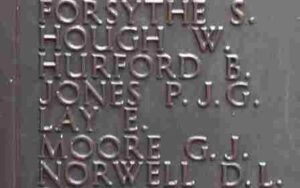
John Evans Llewelyn, Chief Officer, Merchant Navy. John was the Husband of Margaret Elizabeth Llewelyn, of St. Dogmaels. He served with the Merchant Navy aboard the MV British Security, a London registered tanker. On 20 May 1941, British Security was on route from Curacao to Bowling in Convoy HX-126, carrying a cargo of benzene and kerosene when she was torpedoed and sunk by the German submarine U-556, south of Cape Farewell. John was 45 years old when he died that day, and is commemorated on the Tower Hill Memorial, London.
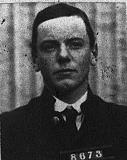
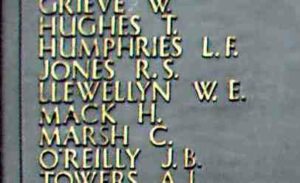
William Eirwyn Llewellyn, Sailor, Merchant Navy. William was the son of William John and Addie Llewellyn, of Dryslwyn, High Street, St. Dogmaels. He served with the Merchant Navy aboard the MV Canadian Star, a London registered cargo vessel. on 18 March 1943, Canadian Star was attached to Convoy HX-229, when she was struck by two torpedoes from the German submarine U-221, and sank with the loss of 34 lives. William was 26 years old when he died that day, and is commemorated on the Tower Hill Memorial, London. William is also commemorated on his parents grave at Blaenwaun Chapelyard.
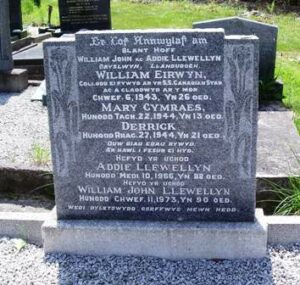
John Richard Gethyn Morgan, Second Engineer Officer, Merchant Navy. John was the son of Joseph Richard and Martha Anna Morgan, of St. Dogmaels. He served with the Merchant Navy aboard the S.S. Empire Tower, a London registered cargo steamer. On 5 March 1943, Empire Tower was in Convoy XK-2, en-route from Huelva and Gibraltar for Middlesbrough, when she was torpedoed and sunk by the German submarine U-130, with the loss of 38 lives. John was 29 years old when he died that day, and is commemorated on the Tower Hill Memorial, London.
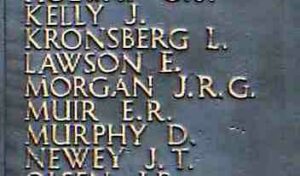
George Richard Nicholas, Coder, D/JX 211387, Royal Navy. George was the son of David Henry and Louise Nicholas, of St. Dogmaels. He served with the Royal Navy aboard H.M. Trawler Stella Capella, and anti-submarine trawler. On 19 March 1942, Stella Capella was on patrol off Iceland, when she was torpedoed by the German submarine U-701, and sank with the loss of 33 lives. George was 22 years old when he died that day, and is commemorated on the Plymouth Naval Memorial, Devon.
Martyn Owen, Third Engineer Officer, Merchant Navy. Martyn served with the Merchant Navy aboard the MV Lady Glanely, a Cardiff registered steamer. On 2 December 1940, Lady Glanely was on route from Vancouver via Panama and Bermuda to London carrying a cargo of wheat and timber, when she was torpedoed by the German submarine U-101, and sank with the loss of 31 men. Martyn is commemorated on the Tower Hill Memorial, London.
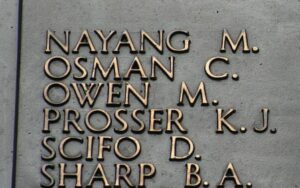
Richard Thomas Owen, Fourth Engineer Officer, Merchant Navy. Richard was the son of Griffith and Martha Owen, of Brynteg, St. Dogmaels, and the husband of Sarah Owen, of Felinfach. He served with the Merchant Navy aboard the SS Henri Mory, a Swansea registered steamer, along with his close friend Daniel Davies, of Cribyn. On 26 April 1941, Henri Mory was torpedoed and sunk by the German submarine U-110 in the Atlantic. Richard was 41 years old when he died that day, and he is commemorated on the Tower Hill Memorial, London.
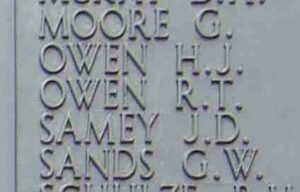
Thomas Daniel Phillips, Fourth Engineer Officer, Merchant Navy. Thomas was the son of Mr. and Mrs. Albert Phillips, of St. Dogmaels, and the husband of Phyllis E. Phillips, of Kilburn, Middlesex. He served with the Merchant Navy aboard the S.S. Barbara Marie, a Newcastle-on-Tyne registered cargo steamer. On 12 June 1940, Barbara Marie was torpedoed by the German submarine U-46, and sank with the loss of 32 lives. Thomas was 25 years old when he died that day, and is commemorated on the Tower Hill Memorial, London.
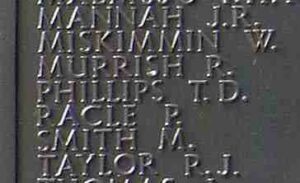
William Lawson Ewart Radford, Marine, PLY/X. 2721, Royal Marines. William was born at Bristol in 1921. He served with the Royal Marines, and married Dorothy M. Griffiths, of Hillside, Pilot Street, St. Dogmaels in 1942. Nothing more is presently known of him, but he died at Basingstoke on 15 June 1943 after breaking his back in an accident, and was buried at St. Dogmael’s (St. Thomas) Churchyard on 25 June. Buried in the same grave is Christine Evans.
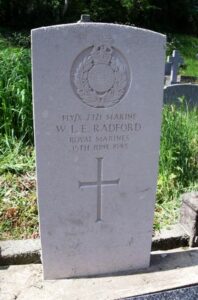
David Picton Rees, Third Engineer Officer, Merchant Navy. David was the son of Edwin and Esther Rees, and the husband of Violet Eurhonwen Rees, of Cardigan. He served with the Merchant Navy aboard the MV British Resource, a London registered tanker. On 14 March 1942, she was torpedoed by the German submarine U-124 north of Bermuda, caught fire and sank, with the loss of 45 lives. David was 27 years old when he died that day, and is commemorated on the Tower Hill Memorial, London.
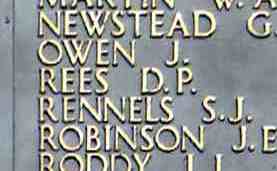
S. J. Rogers, Driver, Royal Army Service Corps. This man cannot presently be identified.
Edward David Salmon, Private, 3970570, Royal Sussex Regiment. Edward was the son of Daniel and Margaret Salmon, of Cardigan View, St. Dogmaels. He married Betty Meiron Williams, of Llanelly in 1941, prior to embarking for North Africa with the 1st Battalion, Royal Sussex Regiment. The battalion took part in the North African campaign, before joining the invasion force for Sicily and Italy in 1943. Edward was killed in Italy on 25 May 1944, aged 27, and is buried at Sangro River War Cemetery, Italy. He is commemorated on his wife’s grave at Llanelli, and on his parents headstone at St. Dogmaels.
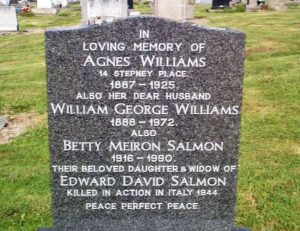
John Sambrook, Boatswain, Merchant Navy. John was the son of William and Elizabeth Sambrook, and the husband of Lily H. Sambrook, of St. Dogmaels. He served with the Merchant Navy aboard the S.S. Brinkburn, a Sunderland registered cargo steamer. On 21 June 1943, Brinkburn was in convoy TE-22, when she was torpedoed by the German submarine U-73, and sank with the loss of 27 lives. John was 47 years old when he died that day, and is commemorated on the Tower Hill Memorial, London.
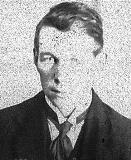
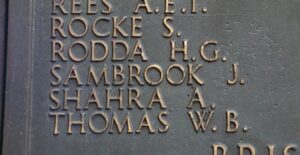
Evan John Verdun Thomas, Third Officer, Merchant Navy. John was the son of Thomas and Annie Jane Thomas of St. Dogmaels, and the husband of Dorothy Thomas, of Hopkinstown, Pontypridd, Glamorgan. He served with the Merchant Navy aboard the S.S. Clarissa Radcliffe, a London registered cargo steamer. On 9 March 1943 Clarissa Radcliffe was limping behind convoy SC-122 when she was torpedoed and sunk by the German submarine U-663 west of Boston, with the loss of 54 lives. John was 24 years old when he died that day, and is commemorated on the Tower Hill Memorial, London.
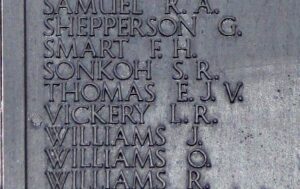
Lewis Robson Thomas, Third Engineer Officer, Merchant Navy. Lewis was the son of Lewis and Elizabeth Thomas, of 2, Bryntion, Penhriw, St Dogmaels. He had served his apprenticeship at a local foundry before joining the Merchant Navy, and during the war served aboard the S.S. Biela, a Liverpool registered cargo steamer. On 14 February 1942 Biela was on route from Liverpool for Buenos Aires in Convoy ON-62 when she was torpedoed by the German submarine U-98 and sunk with the loss of all 49 of her crew. Lewis was 48 years old when he died that day, and is commemorated on the Tower Hill Memorial, London. Two of his brothers, David John and James Louis Thomas, fell during the Great War.
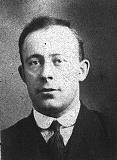
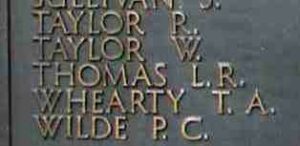
Robin Hugh Thomas, Flight Lieutenant, 103025, Royal Air Force Volunteer Reserve. Robin was the son of Cecil E. W. and Kate Thomas, of Sea View, St. Dogmaels, and the husband of Mildred Joyce Thomas, of Huyton Quarry, Lancashire. He served as a pilot with 418 (R.C.A.F.) Squadron, Royal Air Force, which was an elite unit, equipped with the De Havilland Mosquito. On 30 September 1944 Robin took off in Mosquito Serial NS906 from RAF Coltishall, Norfolk, on a mission to Grove, Aalborg and Copenhagen. While flying over the Grib Forest, near Maarum, Denmark, a wing ripped off the Mosquito, and it plunged into the ground, killing Robin and his Navigator Gilbert Allin. German soldiers buried their bodies near the crash site, but the location of the grave was lost, and the men are now commemorated on the Runnymede Memorial, Surrey. Robin was just 22 years old.
Daniel Gwilym Williams, Chief Engineer, Merchant Navy. Daniel was the Husband of Helena Mary Williams, of 2, Lewis Terrace, St. Dogmaels. He served with the Merchant Navy aboard the SS Leo Dawson, a Newcastle-on-Tyne registered cargo ship. On 29 January 1940, Leo Dawson was on route carrying iron ore from Narvik for Immingham, when she was torpedoed and sunk by the German submarine U-37, with the loss of all her crew. Daniel was 50 years old, and is commemorated on the Tower Hill Memorial, London.
